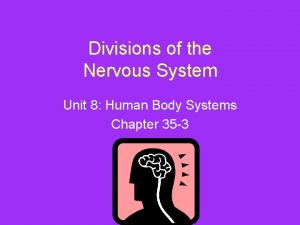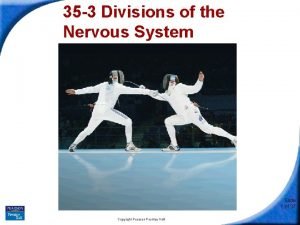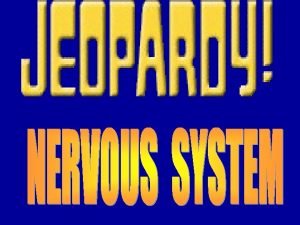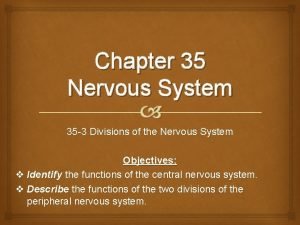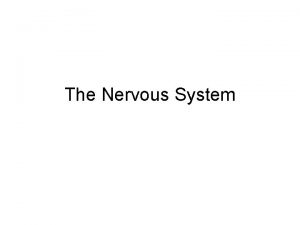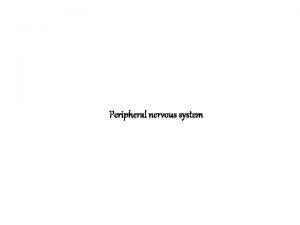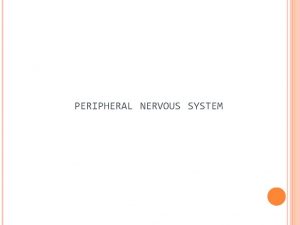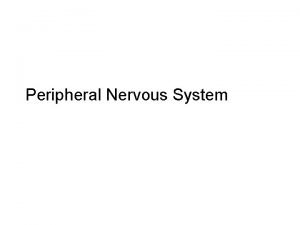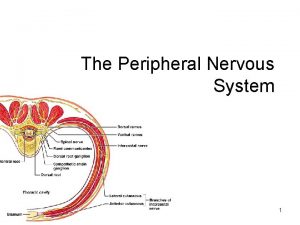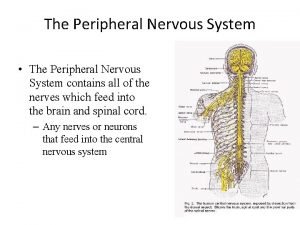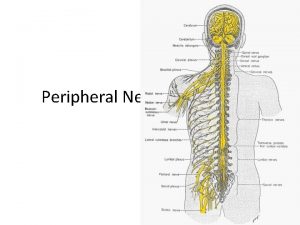PERIPHERAL NERVOUS SYSTEM Chapter 31 Two Major Divisions







- Slides: 7

PERIPHERAL NERVOUS SYSTEM Chapter 31

Two Major Divisions: ■ 1. Sensory Division- transmits impulses from sense organs to CNS ■ Sensory receptors – cells that detect changes (stimuli) in internal/external environment ■ Receptors categorized by type of stimuli they respond to ■ When stimulated, sensory receptors send impulses to sensory neurons which then send the impulse. Type to the CNS Responds to Some Locations Chemoreceptor Chemicals Mouth, nose, blood vessels Photoreceptor Light Eyes Mechanoreceptor Touch, pressure, vibrations, and stretch Skin, hair follicles, ears, ligaments, tendons Thermoreceptor Temperature changes Skin, hypothalamus Pain receptor Tissue injury Throughout the body

■ 2. Motor Division- transmits impulses from CNS to muscles & glands ■ A. Somatic NS- regulates body activities under conscious control (skeletal muscles); BUT when in danger CNS takes over ■ a. Voluntary Control ■ i. Impulse from brain sent to the spinal cord synapse with dendrites on ■ motor neurons travel through axons of motor neuron causes muscle contraction ■ b. Reflex Arc: Some actions occur AUTOMATICALLY rapid response or REFLEX

How a Reflex Arc Works 1. Sensory receptors react to stimuli and send impulse to sensory neurons 1. Sensory neurons relay info to spinal cord 2. Interneuron in spinal cord processes and forms response 3. Motor neuron carries impulse to effector (muscle it stimulates) 4. Muscle contracts and reaction made ■ MEANWHILE… info about injury sent to brain, delay before pain felt. ■ Reflex in head are controlled by brain not spinal cord!

Subdivision of Motor Division ■ B. Autonomic Nervous System- regulates activities that are involuntary or not under conscious control – E. g. During exercise speeds up heart rate and blood flow to skeletal muscles, stimulates sweat glands, slows contractions of smooth muscles in digestive system – Two subdivisions below have opposite effects on each organ they influence

Subdivisions of Autonomic NS – Sympathetic NS- prepares body for intense activity; stimulate the body's fight-or flight response ■ Causes increase in blood pressure, release of sugar into blood, – Parasympathetic NS- “rest and digest” response ■ Lowers heart rate and blood pressure, activates digestion, activates food storage in body tissues



